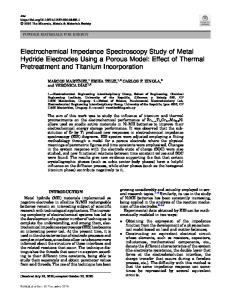A Study of Diffusion in Lithium-ion Electrodes Under Fast Charging Using Electrochemical Impedance Spectroscopy
- PDF / 695,885 Bytes
- 7 Pages / 612 x 792 pts (letter) Page_size
- 35 Downloads / 306 Views
A Study of Diffusion in Lithium-ion Electrodes Under Fast Charging Using Electrochemical Impedance Spectroscopy Kazi Ahmed1, Jeffrey Bell2, Rachel Ye2, Bo Dong1, Yige Li2,3, Cengiz S. Ozkan2,3, Mihrimah Ozkan1 1 Department of Electrical and Computer Engineering, University of California, Riverside 2 Materials Science and Engineering Program, University of California, Riverside 3 Department of Mechanical Engineering, University of California, Riverside
ABSTRACT An in-depth look at diffusion mechanics within lithium-ion electrodes under fast charging conditions is presented. Electrochemical impedance spectroscopy is used as the primary technique to investigate lithium diffusion within electrode material and in electrolyte near the electrode-electrolyte interface. Half-cells of silicon are charged under varying galvanostatic rates while obtaining impedance data. Collected data is analyzed with the help of an electrical equivalent circuit model that provides mechanical and electrochemical parameters for each instance. The novelty of this equivalent circuit partly lies in its ability to resolve between solidphase diffusion and liquid-phase diffusion, both of which occur during cycling of a lithium-ion electrode. Observed patterns in the parameters of this circuit provide insight into impact of fast charging on mechanics of lithium diffusion, both inside the electrode matrix and within electrolyte.
INTRODUCTION Accurate modeling of lithium-ion cells is necessary to carry out a multitude of essential tasks, including, i) material assessment for the performance and safety of novel electrodes, ii) determination of the cell state of charge (SOC) during operation for effective battery management, and ii) determination of cell state of health (SOH) to prevent failures and assess future use. Due to the importance of modeling electrochemical phenomena within lithium-ion cells[1], both theoretical[2] and experimental[3] research efforts into these topics remain active. There are multiple forms of electrochemical impedance present within a lithium-ion cell. These impedances can be categorized in the following way – i) kinetics dominated, and ii) diffusion dominated. Electrons participating in the oxidation-reduction of lithium ions tend to be kinetically limited, while the bulkier ions and atoms (of Lithium) tend to be diffusion limited. Understanding the various nature of diffusion within lithium-ion cells is tied to deciphering an accurate and high throughput model[4][5]. The use of electrochemical impedance spectroscopy[6] (EIS) have been shown to be effective in characterizing diffusion within electrochemical cells[7][8]. Here, we used an electrical equivalent circuit (EEC) model to characterize diffusion within silicon half-cells under varying cycling rates.
Downloaded from https:/www.cambridge.org/core. Columbia University Libraries, on 26 Jun 2017 at 01:26:43, subject to the Cambridge Core terms of use, available at https:/www.cambridge.org/core/terms. https://doi.org/10.1557/adv.2017.451
METHODS Silicon electrode was p
Data Loading...











